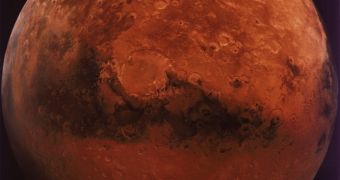By analyzing the red planet's clouds, Phoenix Mars Lander has found that there's snow falling from them. The data collected from the soil samples gathered by the craft showed that there is an obvious interaction between water in liquid form and minerals, just like on Earth.
The laser device that is specially crafted in order to find out more of the ways the Martian atmosphere interacts with the planet's surface recently discovered snow from the 4 km (2.5 miles)-high clouds over it. Unfortunately, it also proved that snow melts and vaporizes before it touches the ground. Jim Whiteway from York University in Toronto, the lead scientist for the Canadian-supplied Meteorological Station on Phoenix, is surprised: “Nothing like this view has ever been seen on Mars. We'll be looking for signs that the snow may even reach the ground”.
The results of the soil analysis also indicated the possibility of calcium carbonate presence, the main chalk component, as well as other particles which could be clay. This could further prove that liquid water once existed there, since on Earth, clay and most of the carbonates form when water is present. Still, more data and analysis are required until scientists can be certain that things happened the same way on Mars. The Thermal and Evolved Gas Analyzer (TEGA) and the wet chemistry laboratory of the Microscopy, Electrochemistry and Conductivity Analyzer (MECA) are responsible for the discovery and study of clay and calcium carbonates.
Originally, the Phoenix mission was only programmed to last for three months, but it has just entered its fifth month of activity and it's working a lot better than expected. Sadly, the decrease in the energy amount it receives from the Sun will soon prevent from functioning any longer. Before that, Phoenix will attempt one more experiment, consisting of capturing sounds from Mars' surface via a microphone. Barry Goldstein, JPL Phoenix project manager, explains, “For nearly three months after landing, the sun never went below the horizon at our landing site. Now it is gone for more than four hours each night, and the output from our solar panels is dropping each week. Before the end of October, there won't be enough energy to keep using the robotic arm”.

 14 DAY TRIAL //
14 DAY TRIAL //